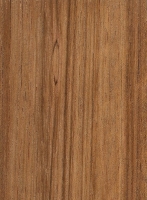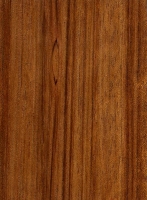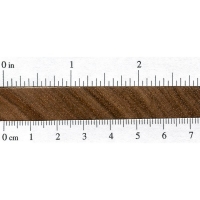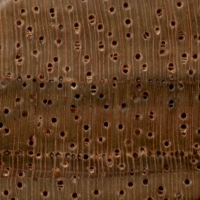 |
Common Name(s): Etimoe, African Etimoe Scientific Name: Copaifera spp. (C. mildbraedii and C. salikounda) Distribution: West and Central Africa Tree Size: 100-165 ft (30-50 m) tall, 3-5 ft (1-1.5 m) trunk diameter Average Dried Weight: 47 lbs/ft3 (755 kg/m3) Specific Gravity (Basic, 12% MC): .58, .76 Janka Hardness: 1,660 lbf (7,380 N) Modulus of Rupture: 20,650 lbf/in2 (142.4 MPa) Elastic Modulus: 1,994,000 lbf/in2 (13.75 GPa) Crushing Strength: 10,030 lbf/in2 (69.1 MPa) Shrinkage: Radial: 5.0%, Tangential: 8.2%, Volumetric: 13.5%, T/R Ratio: 1.6 |
Color/Appearance: Heartwood is a reddish brown, sometimes with darker streaks present. Sapwood is a pale yellow. Frequently seen with a curly of fiddleback grain pattern.
Grain/Texture: Grain is generally straight or slightly interlocked. Fine to medium texture with good natural luster.
Endgrain: Diffuse-porous; solitary and radial multiples; large pores in no specific arrangement, few to very few, gum deposits occasionally present; parenchyma vasicentric, lozenge, and marginal; narrow to medium rays, spacing normal.
Rot Resistance: Rated as durable to moderately durable. Moderate insect resistance.
Workability: Generally easy to work with hand or machine tools, though resin present in the wood has a tendency to clog and gum up tools. Turns, glues, and finishes well.
Odor: Has a unique odor when being worked. The resin from the wood and bark is sometimes used within its natural range in Africa as perfume.
Allergies/Toxicity: Besides the standard health risks associated with any type of wood dust, no further health reactions have been associated with Etimoe. See the articles Wood Allergies and Toxicity and Wood Dust Safety for more information.
Pricing/Availability: Almost always sold as veneer, Etimoe is usually available for a modest price, though figured or curly veneer is slightly more expensive.
Sustainability: This wood species is not listed in the CITES Appendices, but is on the IUCN Red List. It is listed as vulnerable due to a population reduction of over 20% in the past three generations, caused by exploitation.
Common Uses: Veneer, plywood, furniture, flooring, and turned objects.
Comments: Although Etimoe is nearly always sold in veneer form, ironically it has one of the best strength-to-weight-ratios (in terms of modulus of rupture as compared to average dried weight) of any wood in the world.
None available.








Is etimoe similar characteristics to copaifera reticulata or any of the south american copaiba species?
I would add that this wood shows amazing chatoyance!
Buongiorno signor Pisani, può spiegare meglio il suo commento? Il traduttore mi dice :” Vorrei aggiungere che questo legno presenta un sorprendente castigo! ” Cosa vuol dire? Glielo chiedo perché mi è stato proposto di utilizzarlo per tornirlo e ricavare dei piedi per poltrona. Grazie.
Buongiorno signor Pasqualetto, non so se questa traduzione sia giusta ma questa è una traduzione della parola chatoyant:
mostra una fascia di luce riflessa brillante causata da inclusioni allineate nella pietra.